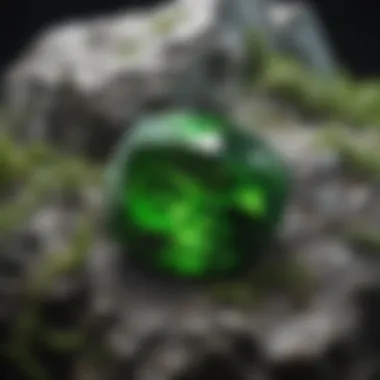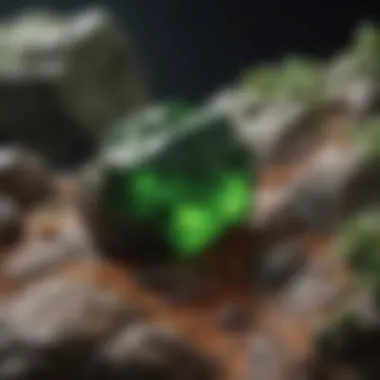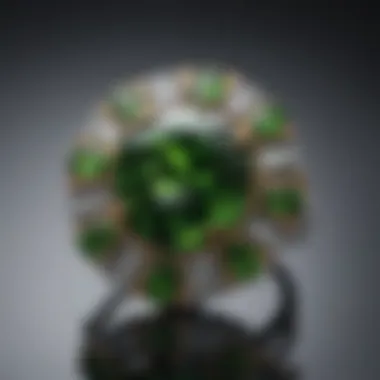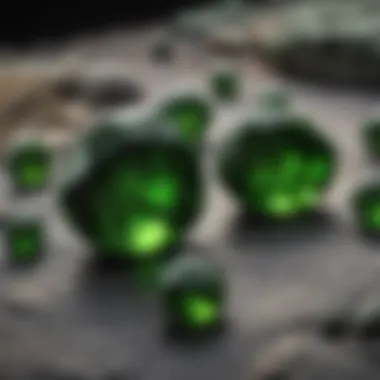Unveiling Chrome Diopside: Properties and Significance


Intro
Chrome diopside is a fascinating mineral that draws the attention of collectors and enthusiasts alike. It is particularly known for its rich green color, which is enhanced by the presence of chromium. This stone not only catches the eye but also has a deep geological history, making it worthy of exploration. Understanding its origin, composition, and the unique properties it possesses can enrich the knowledge of anyone interested in minerals.
Featured Collectible of the Month
Overview
As a collectible, chrome diopside stands out for its striking appearance and rarity. This stone is found primarily in Russia, particularly in Siberia. Its vibrant green hues are reminiscent of emeralds, although its properties and formation differ significantly. Collectors prize chrome diopside not only for its beauty but also for the stories behind each piece. Some stones contain unique inclusions that can make a specific specimen particularly valuable.
Historical Significance
The history of chrome diopside is relatively recent compared to other gemstones. It was first discovered in the 1980s and was soon celebrated for its beauty and rarity. The stone has cultural significance in various regions, particularly among those who appreciate its natural origins. In some cultures, it has been regarded as a symbol of prosperity and harmony. Collectors today value it not just for aesthetics but also for its unique story and the place it holds in the mineral kingdom.
Identification Techniques
Visual Characteristics
Identifying chrome diopside involves examining several key characteristics. The most notable trait is its color, which ranges from a deep forest green to a lighter olive hue. Its transparency can vary, and many gems exhibit a vitreous luster. Here are some specific traits to help in identification:
- Color: Typically green, with possible hints of brown or yellow.
- Luster: Vitreous to greasy.
- Transparency: Transparent to translucent.
- Cleavage: Perfect in one direction, which can affect how it breaks.
Knowing these characteristics will aid collectors in distinguishing chrome diopside from similar stones such as emerald or jade.
Resources for Identification
To deepen knowledge about chrome diopside, several resources can help:
- Wikipedia: Chrome Diopside
- Britannica: Diopside
- Reddit: A community for user discussions and experiences with minerals.
- Facebook: Groups specific to mineral collection can be valuable for networking and learning from other enthusiasts.
Using these resources allows for not just identification, but also insights into trends and developments in the world of mineral collecting.
"Every piece of chrome diopside holds a story, reflecting its origins deep within the earth's crust, waiting for collectors to uncover its secrets."
Understanding chrome diopside offers a rewarding experience for collectors, providing not just a tangible object of beauty, but also a rich narrative steeped in geology and culture.
Foreword to Chrome Diopside
Chrome diopside is a mineral with unique properties that draw the attention of collectors and gem enthusiasts alike. Understanding this stone's significance is crucial to appreciate its value in both natural history and modern applications. This section aims to establish a foundation for the reader by addressing its definition, basic characteristics, and geographical distribution.
Definition and Basic Characteristics
Chrome diopside belongs to the pyroxene group of minerals, characterized by its rich green color. The vibrant hue results from the presence of chromium, which gives this stone its name. It is often confused with other green stones, such as jade or emerald, but its specific structure distinguishes it. The hardness of chrome diopside ranks between 5.5 and 6 on the Mohs scale. This makes it relatively susceptible to scratches, demanding careful handling. The transparency of chrome diopside varies, ranging from transparent to translucent, with clear specimens being particularly sought after. Notably, the gemstone exhibits a unique character of pleochroism, meaning it can show different colors when viewed from different angles.
Geographical Distribution
Chrome diopside can be found in several locations around the globe, but its primary sources are in Russia, specifically in Siberia. The Ural Mountains have proven to be a hotbed for high-quality chrome diopside. Additionally, deposits have been discovered in places like Canada, the United States, and South Africa. Each geographical location imparts its own distinct quality to the stones, influencing color saturation and clarity. This distribution pattern not only contributes to the mineral's availability but also its market value, as stones from renowned locations generally command higher prices. Understanding where chrome diopside originates helps collectors ascertain the authenticity and quality of their specimens.
"The allure of chrome diopside lies not just in its beauty, but also in its complex geological journey."
In summary, the knowledge of chrome diopside's definition and geographical characteristics provides a solid groundwork for delving deeper into its geological formation, properties, and applications. As we continue this exploration, the significance of this gemstone in various contexts will become increasingly clear.
Geological Formation
The geological formation of chrome diopside is a crucial aspect of understanding its unique properties and applications. This section dives into the essential elements behind the mineral's composition and the specific conditions under which it forms. Such knowledge enriches the collector's perspective on this stone and its intrinsic value.


Mineral Composition
Chrome diopside predominantly contains calcium, magnesium, and iron, featuring a significant amount of chromium. Its chemical formula is often presented as CaMgSi2O6. The presence of chromium is what gives this mineral its distinctive deep green hue, often likened to emerald. Collectors appreciate the variance in shades, which can range from light green to almost black, depending on the levels of chromium and iron.
When observing chrome diopside, one may notice that its crystal structure belongs to the pyroxene group, typically exhibiting a prismatic habit. The mineral crystalizes in the monoclinic system, leading to unique facets that contribute to the stone's aesthetic properties. Without understanding this composition, it is challenging to appreciate the stone's rarity and allure in collections.
Formation Conditions
The formation of chrome diopside occurs primarily in ultramafic rocks. These rocks are rich in magnesium and iron and occur often in the Earth's mantle. The high temperatures and pressures in these environments facilitate the necessary chemical reactions for chrome diopside's formation. Typically, the stone forms in the vicinity of metamorphic processes where chromium-bearing metamorphic rocks are subjected to high-grade metamorphism.
The formation conditions can be extremely variable. Under low-temperature circumstances, chrome diopside may form alongside other minerals like olivine and garnet. In contrast, at higher temperatures, it can be found with minerals such as pyroxene and spinel. This adaptability in formation conditions contributes to the mineral's diverse occurrence worldwide.
"The intricate dance of temperature and pressure during the formation of chrome diopside highlights the remarkable processes of our Earth's geology."
For additional information on mineral composition and geological elements, you can explore resources such as Wikipedia and Britannica.
Properties of Chrome Diopside
Understanding the properties of chrome diopside is essential for collectors and enthusiasts alike. This stone is not just about its appearance; its physical, optical, and chemical characteristics contribute to its allure and value. Knowing these aspects can enhance one’s appreciation and help in making informed decisions when acquiring this mineral.
Physical Properties
Chrome diopside is a transparent to translucent stone. Its hardness on the Mohs scale ranges between 5.5 to 6.5, which means it is reasonably durable but can be scratched by harder materials. It exhibits a distinct cleavage, which can present challenges in cutting and polishing. The specific gravity of this stone typically lies between 3.30 to 3.40. This property is important as it gives insights into the density of the material. A higher specific gravity may suggest a better quality piece, which is often desirable in jewelry-making or display.
Some of the other physical properties to note include:
- Color: The most notable feature is its rich green hue, stemming from the presence of chromium.
- Transparency: It can range from translucent to opaque, affecting its use in various applications.
- Luster: Chrome diopside exhibits a vitreous to subvitreous luster, enhancing its visual appeal.
Optical Characteristics
Optical properties of chrome diopside further enhance its desirability. The stone is often known for its pleochroism, which means it can display different colors when viewed from different angles. Common colors observed are various shades of green. This feature adds to the gemstone's uniqueness and can make it more sought after by collectors.
- Refractive Index: The refractive index of chrome diopside ranges from 1.66 to 1.70, which is significantly higher than other common gemstones. This trait can contribute to its brilliance.
- Birefringence: It shows a moderate level of birefringence, making it essential for gemologists to understand this characteristic when identifying and valuing the stone.
- Double Refraction: Like many other minerals, chrome diopside also exhibits double refraction, which can aid in identifying its authenticity.
Chemical Properties
Chemically, chrome diopside is classified as a silicate mineral. Its primary chemical composition includes magnesium, iron, and chromium. The presence of chromium is what gives it the distinctive green color. Understanding its chemical properties is crucial for collectors, as they affect not only the stone’s value but also its stability.
Key chemical traits include:
- Formula: The general chemical formula for chrome diopside is MgCaSi2O6. This informs collectors about its basic structure.
- Stability: Chrome diopside is relatively stable under normal conditions; however, exposure to extreme heat or certain chemicals can lead to degradation over time.
- Allergic Reaction: It is believed to be hypoallergenic, making it suitable for everyone.
In summary, the physical, optical, and chemical properties of chrome diopside shape its identity. Collectors can appreciate not just its beauty but also the scientific principles that underline its existence. This understanding can lead to better choices when selecting pieces for collections or jewelry designs.
"Knowledge of a stone's properties allows collectors to appreciate its full potential rather than just its aesthetic appeal."
For further research about the composition and characteristics of chrome diopside, you may refer to external resources like Wikipedia or Britannica.
Cultural and Historical Significance
Chrome diopside holds notable cultural and historical importance, shedding light on both the gemstone's past and its present relevance. Recognizing the stone's significance enriches our understanding of how it has been valued by various civilizations throughout time. This section explores two pivotal areas: its historical usage and its cultural associations.
Historical Usage
The history of chrome diopside extends over centuries, with its first known utilization dating back to the 19th century. Discovered in Siberia, this mineral was appreciated for its vibrant green color and unique properties. Russian gemologists and collectors began to regard it as a valuable gemstone. It was notably used in jewelry, often set into pieces for nobility and tsarist figures.


As a statement of wealth and status, chrome diopside adorned the fashion of the upper class, characterizing their elegance. Its relative rarity contributed to its allure. It became a symbol not just of beauty but also of scarcity. The historical context provides insight into how minerals can embody the values of the era, highlighting chrome diopside's role in society.
In more modern times, the use of chrome diopside has diversified. Its incorporation into various types of jewelry designs continues to appeal to both collectors and casual wearers today. Over time, as sourcing methods improved, the accessibility of chrome diopside increased. Thus, becoming a favored choice among gem enthusiasts despite its historic ties to exclusivity.
Cultural Associations
Beyond its physical attributes, chrome diopside bears numerous cultural associations across different regions. In Eastern cultures, this stone is often linked with healing properties. Its deep green hue symbolizes growth, renewal, and balance. Some believe that wearing chrome diopside can promote emotional well-being and mental clarity, thus enriching its spiritual significance.
In other contexts, the stone has been associated with nature and the Earth. Many regard green gemstones as representations of harmony. Chrome diopside serves as a reminder of the beauty found in nature, drawing collectors who appreciate not just the aesthetic but also the eco-centric philosophy.
Collectively, the cultural significance speaks not only to the stone itself but to humanity's affinity for nature as an expression of identity and spirituality. Understanding these associations helps to elevate chrome diopside beyond a mere gemstone to a central component in various cultural narratives, creating meaningful ties to the past and present.
Applications in Modern Society
The applications of chrome diopside in modern society highlight its significance beyond mere geological curiosity. This mineral's unique properties make it desirable not just for collectors but also for practical applications in various fields. Understanding these applications offers insight into how chrome diopside bridges the gap between aesthetics and utility, embodying both beauty and function.
Use in Jewelry
Chrome diopside has gained popularity in the jewelry market due to its vibrant green color and excellent clarity. Unlike other gemstones, this stone is relatively affordable, making it an attractive option for both consumers and jewelers. Its rich color is mainly due to the presence of chromium, which lends the stone a striking hue reminiscent of emerald, yet it stands apart with its own distinct charm.
When set in jewelry, chrome diopside can be used in various forms. From rings to necklaces, its versatility allows for creative designs appealing to a broad audience. The stone's hardness, rated at 5.5 to 6 on the Mohs scale, allows it to withstand everyday wear, making it suitable for rings worn regularly. However, caution is necessary to avoid scratches or damage. Jewelers often recommend pairing chrome diopside with softer metals like gold or silver to enhance its aesthetic appeal without compromising durability.
"Chrome diopside is the gemstone of the twenty-first century, offering beauty without the hefty price tag."
In addition to traditional settings, there is a growing trend of using chrome diopside in alternative or personalized jewelry. This adaptability allows consumers to express their unique tastes while still enjoying the natural beauty of this stone. Overall, the use of chrome diopside in jewelry not only reflects individual style but also supports the appreciation for natural materials in fashion.
Industrial Applications
Beyond its use in jewelry, chrome diopside finds applications in the industrial sector. Its unique physical and chemical properties make it suitable for various uses, particularly in glass manufacturing and as a refractory material. In glassmaking, chrome diopside can enhance the color and clarity of glass products, which makes it a beneficial additive. Several manufacturers explore its potential in specialized glass types, particularly to create vivid color effects in artistic or functional glassware.
Additionally, due to its heat resistance, chrome diopside is employed in industrial processes that require materials to withstand extreme temperatures. Its ability to maintain structural integrity under such conditions means it is often found in refractory linings and coatings for kilns. This application highlights the mineral's adaptability and utility, proving that its value extends well beyond aesthetics.
In summary, chrome diopside's role in modern society spans from art and fashion to practical industrial uses. Understanding these applications enhances appreciation for this mineral's versatility and encourages sustainable practices among enthusiasts and industries alike.
Identification and Valuation
Identification and valuation of chrome diopside are crucial components of navigating the market for collectors and enthusiasts. Recognizing the unique characteristics of this stone enhances appreciation and understanding. Furthermore, valuation helps collectors determine the worth of their specimens, guiding purchasing decisions and investment strategies. Careful analysis can prevent misunderstandings about quality and authenticity, allowing for more informed choices.
How to Identify Chrome Diopside
Identifying chrome diopside involves observing several key features. The first aspect to consider is color. Chrome diopside shares a rich green hue, often compared to the color of emerald. This vibrant pigmentation is due to chromium content, setting it apart from other gemstones.
Another essential aspect in identification is transparency. Most specimens of chrome diopside display a certain degree of translucency. This means light passes through the stone but does not fully reveal objects on the other side. When evaluating the stone, look for any inclusions or cloudiness, which may indicate lower quality.
A simple test is to check the hardness of the stone. Using the Mohs scale, chrome diopside rates between 5.5 and 6.5. This range indicates it can scratch glass but is more susceptible to scratches than harder minerals like quartz.
Here are some points for identification:
- Color: Look for vibrant green shades.
- Transparency: Check for translucency.
- Hardness: Use the Mohs scale to assess hardness.
Visual characteristics, such as pleochroism, can also provide hints. Chrome diopside may show different colors from different angles, a trait that can distinguish it from other stones.
Assessing Quality and Value
Assessing the quality and value of chrome diopside requires a comprehensive approach. In general terms, quality hinges on several factors including clarity, cut, color, and carat weight. Each of these elements contributes to the overall appeal and market value of the stone.


- Clarity: Clear stones without visible inclusions fetch higher prices. Imperfections can detract from the beauty and perceived value.
- Cut: The cut impacts how well a stone reflects light. A high-quality cut enhances brilliance, elevating its market desirability.
- Color: The intensity of the green affects value. Deeper shades command better pricing.
- Carat Weight: Larger specimens are rarer and, therefore, more valuable.
It can be beneficial to consult with a gemologist or appraiser for an accurate valuation. These experts evaluate each piece based on established standards in the gemstone market. Additionally, keeping up to date with current pricing trends can inform your investment decisions.
"Assessment of value should always consider market demand and condition of the specimen."
Care and Preservation
The significance of care and preservation in maintaining the integrity of chrome diopside cannot be overlooked. This stone, while visually striking, is also relatively soft. Therefore, proper care ensures that it retains its allure and does not degrade over time. Understanding the specific needs of chrome diopside helps collectors and enthusiasts protect their investment while enjoying its beauty.
Maintaining the condition of chrome diopside enhances its durability and appearance. This includes regular cleaning and appropriate storage practices. Damage caused by improper handling can lead to scratches or dullness, significantly diminishing the stone's aesthetic value. Given its unique composition, enthusiasts should adopt targeted techniques for both cleaning and storing this gemstone.
Cleaning Techniques
Cleaning chrome diopside requires a gentle approach to avoid damaging its surface. Here are some recommended techniques:
- Use Mild Soap Solution: A mixture of warm water and a mild dish soap can effectively clean the stone. It is important to avoid harsh chemicals, as they may harm the surface.
- Soft Cloth: Always utilize a soft, lint-free cloth to wipe the stone. Rubbing it with abrasive materials can cause scratches.
- Gentle Rinsing: After cleaning, rinse the stone with clean water to remove any soap residue, but be careful with immersing it fully in water for a long time.
- Dry Properly: Pat dry with another soft cloth to avoid water spots.
"Proper cleaning techniques greatly extend the life of chrome diopside, preserving its beauty for years to come."
Storage Guidelines
Storing chrome diopside correctly is as crucial as cleaning it. Here are some guidelines to follow:
- Use Soft Pouches or Boxes: Store each piece of chrome diopside in its own soft pouch or a lined jewelry box. This prevents contact with other stones that could lead to scratches.
- Avoid Direct Sunlight: Prolonged exposure to sunlight can cause discoloration. Keeping it in a dark or shaded area is advisable.
- Control Humidity: Desirable conditions typically call for moderate humidity. Overly dry or excessively humid conditions can affect the stone's physical state.
- Regular Checks: Periodically examine the stored stones for any signs of damage or change. This will help ensure they remain in good condition.
Ethical Considerations
Understanding the ethical considerations surrounding chrome diopside stone is crucial for collectors and enthusiasts. As with many natural resources, the processes involved in sourcing this gemstone can affect the environment and communities. Ethically sourced diamonds, sapphires, and emeralds have gained attention, and now chrome diopside is under scrutiny as well. Making informed decisions not only benefits the purchasers but also supports sustainable practices that can lead to better outcomes for the industry.
Sustainable Sourcing
Sustainable sourcing refers to acquiring chrome diopside in a way that meets present needs without compromising future generations. This involves practices that ensure minimal environmental impact and support local communities.
- Environmental Impact: It is important to consider how mining operations affect ecosystems. Sustainable practices can help mitigate habitat destruction and pollution.
- Community Well-Being: Supporting local economies through ethical sourcing can empower communities. This ensures that the benefits of mining are distributed fairly, rather than concentrating wealth with a few.
- Transparency: A key element in sustainable sourcing is traceability. Buyers should inquire about the origins of the stone and ensure that it comes from reputable sources.
Incorporating these practices can enhance the value of chrome diopside for collectors who prioritize ethical considerations in their acquisitions.
Ethical Concerns in Mining
Concerns about the mining of chrome diopside extend beyond environmental impacts. There are multiple facets to consider:
- Labor Conditions: Many mining operations, particularly in remote areas, may have poor labor conditions. Ensuring fair wages and safe working environments are fundamental ethical issues.
- Legal Compliance: Illegal mining operations can pose significant problems. Collectors should verify that the stones they purchase comply with local and international mining regulations.
- Conflict Minerals: In some regions, mining profits may finance conflict or suppression. Understanding the geopolitical context of where chrome diopside is sourced is important.
Accordingly, collectors should seek to educate themselves about the ethical landscape of chrome diopside mining. This awareness fosters responsible purchasing decisions:
"By choosing ethically sourced chrome diopside, collectors can be part of a solution that promotes both eco-friendliness and social equity."
The End
In this article, we have examined the nuanced complexities of chrome diopside, a mineral not merely appreciated for its beauty but significant in various domains. This conclusion serves as a reflection on the key insights gained throughout the discussion.
Summary of Key Points
- Definition and Characteristics: Chrome diopside is a vibrant green gemstone, notable for its hardness and brilliance. These properties make it a sought-after stone in jewelry.
- Geological and Geographical Insight: The formation of chrome diopside is intricately tied to specific geological environments, which affects where it is found.
- Cultural Impact: The historical and cultural significance of chrome diopside cannot be overlooked. Many societies have utilized this stone in various forms, symbolizing different cultural values.
- Modern Applications: From jewelry to industrial uses, chrome diopside has numerous applications highlighting its versatility.
- Ethical Sourcing: As awareness around sustainable practices grows, the importance of responsible mining is more pressing than ever.
- Care and Preservation: Proper knowledge of caring for and storing this mineral ensures its longevity and splendor for collectors.
Future of Chrome Diopside in Collecting
The future of chrome diopside in the realm of collecting appears promising yet challenging. As demand increases, especially among collectors and enthusiasts, the implications for sourcing and preservation also heighten.
- Emerging Trends: We may see collectors focusing on unique pieces, including rare forms of chrome diopside with distinct characteristics.
- Increased Awareness: The interest in ethically sourced stones is likely to shape future collecting practices. Collectors will need to prioritize transparency in sourcing.
- Value Appreciation: As chrome diopside becomes less common in the market, its value may appreciate, making it an attractive option for both new and seasoned collectors.



